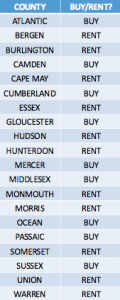Admittedly more commercial real estate than residential – but absolutely linked to NJ’s broader real estate market. Thoughts?
On a recent weekday night, my friend Zeke and I were driving down Route 35 through Monmouth County.
“Look at this,” Zeke said. “There’s no one else on the road.”
He was right. Even though it was only 11 p.m., there were few other cars to be seen – other than the police cruisers lurking at every town line looking for speeders and drunks.
I suspect that explained why all the bars had empty parking lots – even that most sainted of Shore institutions, the go-go bar.
What we were witnessing was the result of an abject failure of New Jersey’s alcoholic beverage licensing system.
First the state tightly controlled the number of licenses so that the only way to make a profit was to locate the bars on major highways.
Then, after having made it impossible to reach a bar by any means other than the automobile, they decided to crack down on drunken driving.
I saw the results of that misguided policy at a hearing in Trenton last week. At issue was a bill that would finally free up the liquor-licensing system that had been turned into a monopoly in 1946 during the governorship of Wally Edge – whose name would later live in infamy when Bridgegate mastermind David Wildstein employed it as his nom de plume.
The first Wally Edge was a do-gooder. I suspect his effort to limit the issuance of new liquor licenses might have seemed like a good idea at the time, when the cities had bars on literally every corner.
The flaw in the system didn’t reveal itself until the mass migration to the suburbs began. The cities got to keep their licenses, but the booming suburbs were limited to one for every 3,000 new residents.
As a result, Hoboken has 140 licenses, or 140 per square mile. Meanwhile my old home town Toms River has a mere 45 licenses in 44 square miles, or about one per square mile. All but a few are in strip malls.
The obvious solution is home rule. Let the residents of each town decide for themselves how many licenses to issue.
Assemblyman John Burzichelli is trying to do just that. The Gloucester County Democrat’s bill that would create a new license that would permit only table service at restaurants. Shot-and-beer joints need not apply.
Why has it taken 70 years to propose such an obvious reform? Because the people who control the current licenses also control the Legislature. At the slightest hint of competition they show up en masse to inveigh against the free market.
They did so on at a committee hearing Monday on the bill, making the absurd argument that there are at present both too many and too few licenses.
The lobbyists argued that the proof there are too many licenses is that the number of bars has dropped from a one-time high of 15,000 to the current number of 7,500.
Therefore there’s no demand for new licenses.
Fair enough. But they then went on to argue that if the towns could start issuing new licenses, restaurant owners would immediately buy them up these licenses no one wants by the thousands.
That makes no sense, Rutgers Professor Morris Davis told the committee members. Davis, an economist who specializes in real estate, argues that development in New Jersey has been hamstrung by the state’s archaic liquor laws.
“If we’re going to encourage the revitalization of our communities, this seems like a key component,” said Davis. “Restaurants need liquor licenses to survive.”
The old model of locating bars in strip malls out on the highway is a proven failure, he said, not just because of DWI laws but also because strip malls themselves are failing.
Which is the free country? In Cuba you can buy a beer from a vending machine; in Jersey you can’t even buy one in a restaurant. Rick Shaftan
“We’re in a situation where we’re basically out of developable land,” he said. “The revitalization of downtowns has to be where we have growth.”

